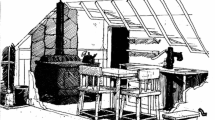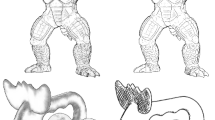Abstract
Various methods such as stippling, hatching, or hedcut are being used to express the brightness of images as a tone. In this paper, as a new method of tonal depiction, we use the mathematical model used in biology for the purpose of expanding the area of non-photorealistic rendering. The model of reaction–diffusion, which is used to depict the skin patterns of diverse animals, has relatively recently been used as the technique of NPR. The biggest obstacle in processing this technique in real time is that it is very time-consuming process of the repeated calculation. In this contribution, we proposed how to build a mask creating similar results in order to gain instant results from the brightness of images. Mask is a two-dimensional table, which is beforehand calculated and used in digital halftoning, can process each pixel of pictures and produce the quickest result. Although the mask obtained as a result uses a uniform size repeatedly throughout the whole images, it has the merit of the repeated parts not being exposed because of the continuity of the connected parts. As the result, we compare the images through the masks made by both the existing method by repetition and the suggested method.







Similar content being viewed by others
Abbreviations
- R–D:
-
Reaction–diffusion
- NPR:
-
Non-photorealistic rendering
- IB-AR:
-
Image-based artistic rendering
- TRDP:
-
Thresholded R–D pattern
References
Deussen, O., Hiller, S., van Overveld, C., Strothotte, T.: Floating points: a method for computing stipple drawings. Comput. Graph. Forum 19(3), 41–50 (2000)
Gierer, A., Meinhardt, H.: A theory of biological pattern formation. Kybernetik 12, 30–39 (1972)
Gray, P., Scott, S.K.: Autocatalytic reactions in the isothermal continuous stirred tank reactor. Chem. Eng. Sci. 39, 1087–1097 (1984)
Hiller, S., Hellwig, H., Deussen, O.: Beyond stippling—methods for distributing objects on the plane. Computer Graphics Forum 22(3), 515–522 (2003). (Proc. Of, EUROGRAPHICS 2003)
Jho, C.: Hedcut-style rendering using reaction–diffusion model. Korean Soc. Comput. Game 27(4), 203–209 (2014)
Jho, C.: Continuous tone representation based reaction–diffusion model. Korean Soc Comput Game 28(4), 203–209 (2015)
Kim, S., Woo, I., Maciejewski, R., Ebert, D.S.: Automated hedcut illustration using isophotes. In: Lecture Notes in Computer Science, 2010 Proceedings of 10th International Symposium on Smart Graphics, Banff, Canada, June 24–26, vol. 6133, pp. 172–183 (2010)
Kyprianidis, J.E., Collomosse, J., Wang, T., Isenberg, T.: State of the art: a taxonomy of artistic stylization techniques for images and video. IEEE Trans. Visual Comput. Graphics 19(5), 866–885 (2013)
Lau, D.L., Arce, G.R., Gallagher, N.C.: Digital color halftoning via generalized error-diffusion and vector green-noise masks. IEEE Trans. Image Process. 9(5), 923–935 (2000)
Meinhardt, H.: Models of biological pattern formation. Academic, Lodon (1982)
Mitsa, T., Parker, K.J.: Digital halftoning technique using a blue noise mask. J. Opt. Soc. Am 9(8), 1920–1929 (1992)
Murray, J.D.: Mathematical biology, 3rd edn. Springer-Verlag, New York (2003)
Son, M., Lee, Y., Kang, H., Lee, S.: Structure grid for directional stippling. Graph. Models 73(3), 74–87 (2011)
Ostromoukhov, V., Hersch, R. D.: Artistic screening. In: Proceedings of SIGGRAPH 95, Annual Conference Series, pp. 219–228 (1995)
Perlin, K.: An image synthesizer. Comput. Graph. 19(3), 287–296 (1985). (Proc. SIGGRAPH 1985)
Suarez, J., Farès, B., Boyer, V.: GPU real-time hatching. In: WSCG 2013, 21st International Conference in Central Europe on Computer Graphics, Visualization and Computer Vision, (Technical), Pilsen, Czech Republic, June 24–27, 2013. J. WSCG 21(2), 97–105 (2013)
Turing, A.M.: The chemical basis of morphogenesis. Philos. Trans. R. Soc. Lond. B Biol. Sci. 237(641), 37–72 (1952)
Turk, G.: Generating textures on arbitrary surfaces using reaction–diffusion. Comput. Graph. 25(4), 289–298 (1991). (SIGGRAPH’91)
Ulichney, R.A.: The void-and-cluster method for dither array generation. In: Eogowitz, B.E., Allebach, J.P. (eds) Proceedings SPIE, Human Vision, Visual Processing, Digital Displays IV, vol. 1913, pp. 332–343 (1993)
Winkenbach, G., Salesin, D.H.: Computer-generated pen-and-ink illustration. In: Computer Graphics (Proceedings of ACM SIGGRAPH 94), pp. 91–100 (1994)
Witkin, A., Kass, M.: Reaction–diffusion textures. Computer Graphics 25(3), (1991). (Proc. SIGGRAPH 91)
Worley, S.: A cellular texture basis function, pp. 291–194. Proc SIGGRAPH (1996)
Author information
Authors and Affiliations
Corresponding author
Rights and permissions
About this article
Cite this article
Jho, CW., Lee, WH. Real-time tonal depiction method by reaction–diffusion mask. J Real-Time Image Proc 13, 591–598 (2017). https://doi.org/10.1007/s11554-016-0643-6
Received:
Accepted:
Published:
Issue Date:
DOI: https://doi.org/10.1007/s11554-016-0643-6




